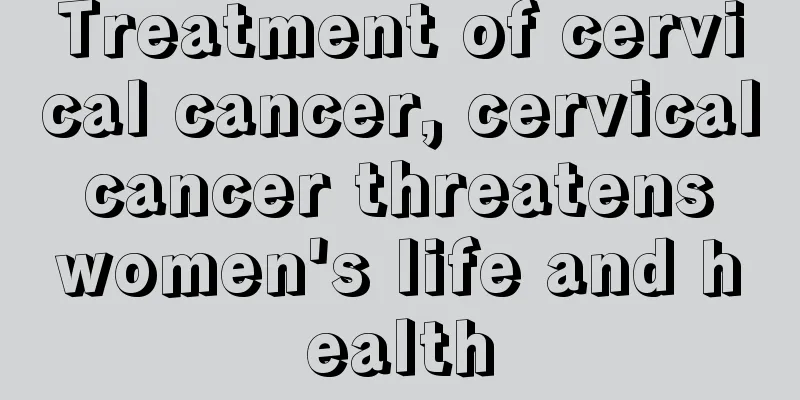Treatment of cervical cancer, cervical cancer threatens women's life and health

|
Cervical cancer is a gynecological disease that is highly prevalent among female friends. It is also the disease that poses the greatest threat to women's life and health. It can be said that if it is not treated in time, it will not only affect women's fertility, but also cause death. Therefore, it must attract the attention of female friends. Treatment is the best way to reduce the harm of cervical cancer to women's bodies. Of course, the treatments for cervical cancer at different stages are also different, but one thing is that the earlier it is discovered, the less pain it will cause to women. At the same time, if cervical cancer is discovered early, the woman's uterus can be preserved to a greater extent. If a woman has her uterus removed, she will no longer have her periods. If your ovaries are not removed, you will not experience the physical changes of menopause because your ovaries will still produce hormones. However, if the ovaries are removed or their function is impaired due to treatment, the physiological changes of menopause will occur. Sexual ability and sexual desire will not change due to the removal of the uterus, but because you can no longer get pregnant, you may have a strong sense of loss. Symptoms and treatment of cervical cancer are relative. What symptoms indicate what stage, and the corresponding treatment should be used. Treatment of cervical cancer Many factors must be considered before deciding the best treatment, including tumor size, patient age and overall health. Treatments for cervical cancer include surgical resection, radiation therapy, and chemotherapy. Stage 0 (carcinoma in situ): The treatment of stage 0 cervical cancer is highly controversial. Most people generally believe that if there is residual lesion at the edge of the cone section, cervical cone resection surgery must be performed again. However, if the patient no longer considers having children, most doctors will recommend a total hysterectomy. Symptoms and treatment of cervical cancer are divided into stages: Stage 1: Simple hysterectomy or cervical cone biopsy. Stage II: IIA is usually treated with hysterectomy plus pelvic lymph node removal, while IIB is usually treated with radiation therapy. After the third and fourth stages (including recurrence): Standard treatment for advanced cervical cancer is the same as 2B treatment, which directly administers high-dose radiation therapy using external beam radiation and close-range radiation therapy. But chemotherapy can temporarily control the progression of the disease, prolong the patient's survival and reduce the patient's pain. There are many chemotherapy and radiotherapy methods currently undergoing clinical research, including: simultaneous implementation of chemotherapy and radiotherapy, chemotherapy before radiotherapy, or chemotherapy after radiotherapy. However, so far, there is no evidence to show which treatment plan has the best effect, and the preliminary results of all studies still need further clinical confirmation. side effect After a hysterectomy, you usually need to stay in the hospital for one to two weeks. A few days after the operation, you may experience difficulty urinating, abnormal bowel movements, and lower abdominal pain, which usually return to normal within one to two months. If a woman has her uterus removed, she will no longer have her periods. If your ovaries are not removed, you will not experience the physical changes of menopause because your ovaries will still produce hormones. However, if the ovaries are removed or their function is impaired due to treatment, the physiological changes of menopause will occur. Sexual ability and sexual desire will not change due to the removal of the uterus, but because you can no longer get pregnant, you may have a strong sense of loss. The most important thing is to match the symptoms and treatment methods of cervical cancer. Cervical cancer is very harmful to women's health. Therefore, women must develop good physical examination habits in daily life so that they can find out whether they have cervical cancer early. This will cause relatively less damage to the female body. |
<<: What are the symptoms of cervical cancer in women?
>>: Symptoms of early and late stage cervical cancer
Recommend
Do you lose weight quickly after starvation? Why not try "tonifying slimming"? Chinese medicine teaches you 3 ways to tonify slimming!
Obesity is like a fulcrum that can easily "l...
Pregnant women feel cold and the fetus is stopped
During pregnancy, pregnant women should pay close...
Siwu Decoction, which replenishes qi and blood, is a classic in gynecological health care!
Siwu Decoction is a health-preserving formula pra...
How to treat kidney deficiency in women
Congenital factors are one of the main causes of ...
Women's private parts care should avoid 4 wrong care practices
Mistake 1: Over-cleaning There is nothing wrong w...
Twenty days after the abortion, blood flowed again
If a woman needs to have an abortion, she needs t...
How long does it take for the side effects of birth control pills to disappear?
Although taking emergency contraceptive pills can...
Can pregnant women eat the placenta?
Most people do not eat the placenta, but some peo...
What should pregnant women with thick belly pay attention to?
Pregnant women will encounter many challenges in ...
How to maintain the uterus after abortion
The female body structure is very complex. Aborti...
What are the symptoms of blood heat in women?
Many people don’t know what blood heat means. In ...
Why does my stomach hurt and my nipples hurt?
If you have pain in your lower abdomen and nipple...
One picture to understand: Still staying up late to use your phone? Be careful that glaucoma "steals" your eyesight
Eyes are the windows to the soul and one of the m...
What are the eight benefits of garbage classification?
The significance of garbage classification is to ...
What is a mass in the fallopian tube?
If you find a lump in your fallopian tube during ...









